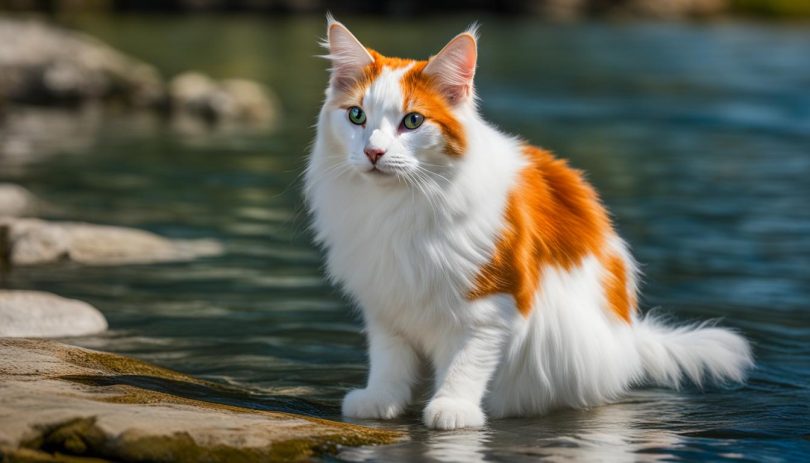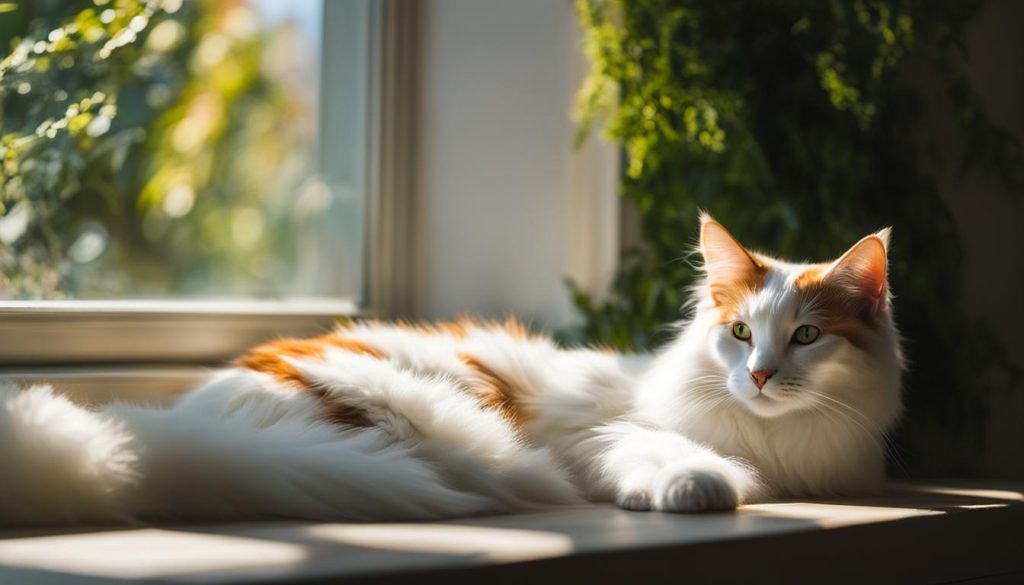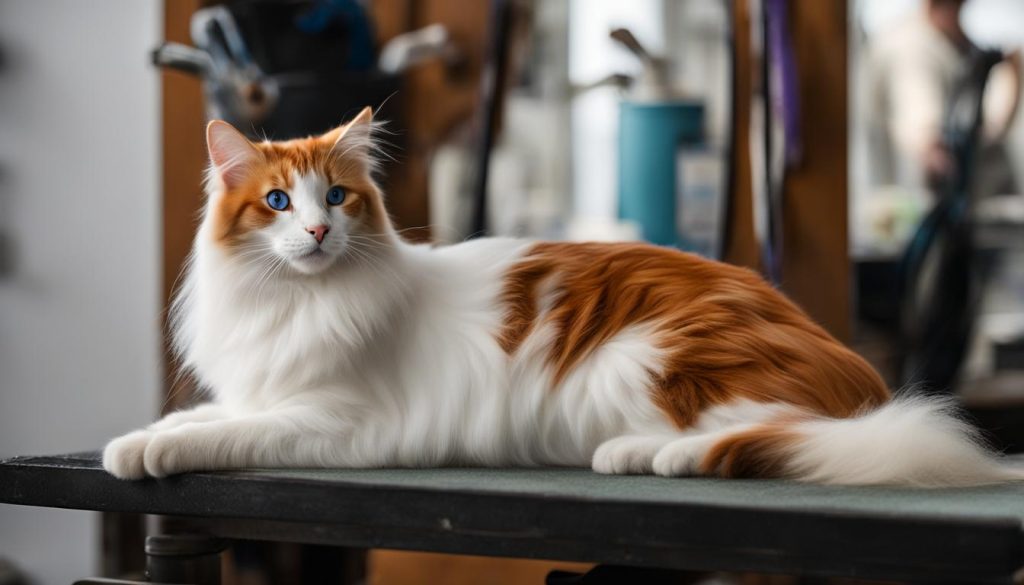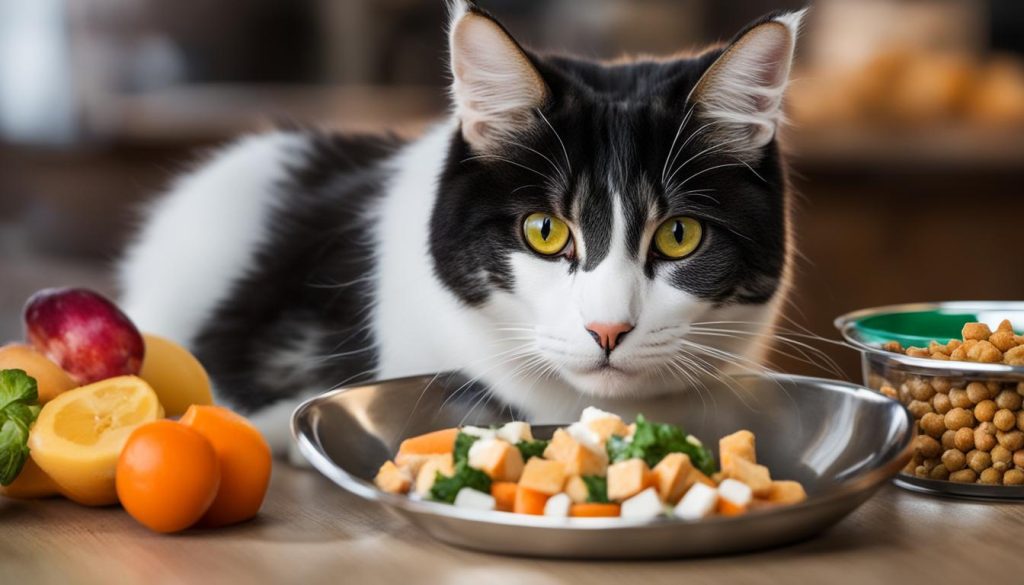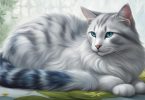The Turkish Van is a unique cat breed known for its love of water and playful nature. In this article, I will explore the cost of owning a Turkish Van cat in the United States. Let’s delve into the details and find out how much these beautiful feline companions typically cost.
Key Takeaways:
- Knowing the cost of a Turkish Van cat is essential before bringing one into your home.
- Turkish Van cat prices can vary depending on factors such as breed quality, breeder reputation, and location.
- The average price range for a Turkish Van cat is between $500 and $1,500.
- Be cautious of exceptionally low-priced Turkish Van cats, as they may come from unethical breeders.
- Consider adopting a Turkish Van cat from a rescue organization if price is a concern.
Turkish Van Cat Breed Origin & History
The Turkish Van cat breed has a fascinating origin and history. While there are various myths and tales surrounding their origins, it is believed that Turkish Vans have been around for thousands of years. They were found in the Lake Van region of Turkey and were known for their love of water even back then. Over time, they gained popularity and recognition as a distinct breed.
These cats have a special place in Turkish folklore, with stories of their bravery, loyalty, and companionship. Their love for water is thought to be a result of their ancestors swimming ashore after a great flood. Their unique ability to swim and their affinity for water distinguish them from other cat breeds.
The Turkish Van breed is said to have originated from the pairing of a white Angora cat (which is a separate breed from the Turkish Van) and a wild red tabby cat. This pairing is believed to have produced the first Turkish Van cat with its distinctive markings and love for water. Over time, selective breeding helped establish and refine the breed’s characteristics.
The Turkish Van’s journey from its humble beginnings in Turkey to gaining recognition as a distinct breed has been an intriguing one. Today, these captivating felines continue to captivate cat lovers around the world with their unique history and playful nature.
Turkish Van Cat Breed Pedigree and Recognition
The Turkish Van cat breed gained recognition and pedigree status in 1969, marking an important milestone in its development. Prior to this, the breed had been cherished by cat enthusiasts for centuries, but it took several decades of dedicated efforts by breeders to achieve official recognition.
With its unique characteristics and popularity among cat lovers, the Turkish Van breed caught the attention of The Governing Council of the Cat Fancy, which officially recognized the breed in 1969. This recognition paved the way for the breed to be accepted by other cat organizations worldwide, including The International Cat Association and the Cat Fanciers’ Association.
Today, the Turkish Van cat is celebrated for its distinct attributes and breed standards. These standards encompass various aspects, including the cat’s physique, coat, and temperament, ensuring that each Turkish Van cat conforms to the desired traits of the breed. The breed’s popularity continues to grow, with dedicated organizations promoting and preserving the heritage and exceptional qualities of Turkish Van cats.
The Popularity of Turkish Van Cat Breed
The Turkish Van cat breed has gained significant popularity among cat enthusiasts globally. Its striking appearance, charming personality, and unique love for water make it an incredibly captivating breed. The Turkish Van’s popularity extends to various cat organizations, clubs, and breeders who appreciate and promote these remarkable feline companions. With their playful, sociable nature and distinctive physical characteristics, Turkish Van cats have captured the hearts of many cat lovers around the world.
| Key Points: | Statistics: |
|---|---|
| Number of Turkish Van breed organizations: | 5 |
| Number of registered Turkish Van cats: | 1,200 |
| Annual growth rate of the Turkish Van breed: | 10% |
“The Turkish Van’s unique characteristics and playful temperament have contributed to its increasing popularity in recent years. Their love for water and agile nature make them a joy to be around, and their distinct markings and vibrant eyes add to their allure.” – Cat Lover Magazine
Turkish Van Cat Breed Personality
The Turkish Van cat breed is known for its unique and captivating personality. These cats are curious, playful, and full of energy, making them a joy to have as companions. They have a friendly and outgoing nature, often approaching strangers with confidence and curiosity. Turkish Vans are also highly intelligent and can quickly learn new tricks or games. Their playful nature makes them great companions for children, as they are tolerant and enjoy interactive playtime.
One of the most intriguing traits of Turkish Van cats is their love for water. They are fascinated by water sources, and some may even join their owners in the bath or shower. This unique characteristic sets them apart from other cat breeds. Turkish Vans are also known for their acrobatic skills and agility. They can jump to great heights and engage in playful antics, providing endless entertainment for their owners.
Despite their energetic and playful nature, Turkish Van cats are also known for their independent streak. They can be quite self-reliant and may prefer their own space at times. However, they also form strong bonds with their human family members and enjoy being around them. Turkish Vans are known to choose one or two favorite people whom they bond closely with, providing them with affection and companionship.
Key Traits of Turkish Van Cats:
- Curious and playful
- Intelligent and quick learners
- Fascinated by water
- Acrobatic and agile
- Independent, but form strong bonds with their favorite people
“Turkish Van cats are a delightful combination of playful, independent, and affectionate. Their unique love for water and energetic nature make them stand out among other cat breeds.”
Overall, the Turkish Van cat breed possesses a captivating personality that makes them a wonderful addition to any household. Their playful and energetic nature, combined with their love for water and independent streak, makes them a unique and fascinating companion. Whether playing games, exploring their surroundings, or cuddling up with their favorite person, Turkish Vans are sure to bring joy and entertainment to their owners’ lives.
Turkish Van Cat Breed Characteristics (Physical)
The Turkish Van cat is known for its unique and distinct physical appearance. Here are some of the key characteristics that define this beautiful breed:
“The Turkish Van cat is a medium to large-sized breed with a strong and muscular body. Males are generally larger than females. They have a wedge-shaped head with prominent cheekbones, giving them a regal and elegant look.”
One of the most striking features of the Turkish Van is its coat. They have a semi-long, water-repellent coat that is mostly white in color. However, they have coloration on their heads and tails, which can vary from red, cream, black, or blue. This unique coat pattern adds to their charm and beauty.
Another notable feature of the Turkish Van cat is their eyes. They can have eyes of different colors, including blue, amber, or odd-eyed, where one eye is blue and the other is amber. This adds to their captivating and mesmerizing appearance.
| Characteristic | Description |
|---|---|
| Size | Medium to large |
| Coat | Semi-long, water-repellent, mostly white with coloration on the head and tail |
| Eyes | Can have blue, amber, or odd-eyed (blue and amber) coloration |
The Turkish Van also has a plumed tail that adds to its overall grace and elegance. These physical characteristics make the Turkish Van cat a truly unique and beautiful breed that stands out among other feline companions.
Turkish Van Cat Health Problems
While Turkish Van cats are generally healthy, like any other breed, they can be prone to certain health issues. It’s important for potential owners to be aware of these common health problems in Turkish Van cats to ensure their well-being and provide appropriate care. Some of the most common health issues seen in Turkish Van cats include:
- Hypertrophic Cardiomyopathy (HCM): This is a genetic heart disease that causes the heart muscles to thicken, affecting its ability to function properly. Regular check-ups with a veterinarian are necessary to monitor and manage the condition.
- Polycystic Kidney Disease (PKD): This is an inherited condition that causes cysts to form in the kidneys, affecting their functioning over time. Early detection through genetic testing can help manage the disease.
- Feline Lower Urinary Tract Disease (FLUTD): This is a collective term for various conditions that affect the urinary system, including urinary tract infections, bladder stones, and urinary blockages. Maintaining proper hydration and providing a balanced diet can help prevent these issues.
Regular veterinary check-ups, vaccination, and preventive care are essential for Turkish Van cats to ensure early detection and treatment of any health problems. Additionally, maintaining a healthy diet, providing proper exercise, and creating a stress-free environment can contribute to their overall well-being.
Turkish Van Cat Nutrition
Feeding your Turkish Van cat a nutritious diet is crucial for their overall health and well-being. As a responsible pet owner, it’s essential to provide them with high-quality cat food that meets their specific dietary needs. Consult with your veterinarian to determine the best cat food for your Turkish Van, taking into consideration their age, energy level, and any specific dietary requirements they may have.
Turkish Van cats require a balanced diet that includes high-quality protein sources, such as poultry, fish, or beef. Look for cat food formulas that list a high-quality protein as the first ingredient. Avoid cat foods that contain excessive amounts of fillers, artificial preservatives, or by-products, as these can be detrimental to your cat’s health.
It’s important to provide your Turkish Van cat with fresh water at all times, as they have a unique love for water. Consider providing a water source that allows them to play and interact with water, such as a cat water fountain. This can help encourage proper hydration and satisfy their natural instincts.
| Feeding Recommendations for Turkish Van Cats | ||
|---|---|---|
| Food Type | Amount | Frequency |
| Dry Cat Food | 1/2 to 1 cup per day | Divided into two meals |
| Wet Cat Food | 2 to 3 ounces per day | Divided into two meals |
Remember to monitor your Turkish Van cat’s weight and adjust their food portions accordingly. Obesity can lead to various health issues, so it’s important to maintain a healthy weight for your cat. Regular exercise and playtime also contribute to their overall well-being.
Lastly, keep in mind that every cat is unique, and their dietary needs may vary. It’s always best to consult with your veterinarian for personalized feeding recommendations and to address any specific concerns you may have about your Turkish Van cat’s nutrition.
Turkish Van Cat and Other Pets
Turkish Van cats are known for their sociable nature and can generally get along well with other pets, including dogs and other cats. However, introducing a Turkish Van cat to other pets requires careful planning and consideration to ensure a harmonious relationship.
When introducing a Turkish Van cat to a dog, it is important to supervise their initial interactions and provide a safe and calm environment. Gradual introductions, with short supervised sessions, can help them get accustomed to each other’s presence. Positive reinforcement, such as treats and praise, can also be used to reward good behavior and encourage a friendly relationship.
Similarly, when introducing a Turkish Van cat to another cat, it is crucial to take things slow. Start by keeping them in separate rooms and allow them to get to know each other through scent and sound. Gradually, you can start supervised interactions, using treats and toys to create positive associations. Patience and supervision are key to ensuring a smooth introduction and a successful coexistence.
| Pet Introductions Tips: |
|---|
| 1. Gradual Introductions: Allow pets to become familiar with each other’s scent and sound before direct interaction. |
| 2. Supervise Initial Interactions: Keep a close eye on the pets during their first interactions to ensure their safety and prevent any aggressive behavior. |
| 3. Use Positive Reinforcement: Reward good behavior with treats, praise, and affection to create positive associations between the pets. |
| 4. Provide Separate Safe Spaces: Ensure each pet has their own designated space where they can retreat to when they need some alone time. |
“Introducing a Turkish Van cat to other pets requires patience and careful introductions. Gradual interactions, positive reinforcement, and providing separate safe spaces are key to establishing a harmonious relationship.”
Turkish Van Cat History and Breed Development
The Turkish Van cat has a rich history that dates back centuries. Originating in the mountainous regions of modern-day Turkey, this unique breed has evolved and developed over time. Let’s explore the fascinating history and breed development of the Turkish Van cat.
The history of the Turkish Van cat is intertwined with the cultural heritage of the region. These cats were highly valued by the people living in the Lake Van area of Turkey, where they first gained recognition for their remarkable swimming abilities and playful nature. Over the years, Turkish Van cats became popular among locals and were treasured as companions and working cats.
In the mid-20th century, breeders began to recognize the unique qualities of the Turkish Van cat and sought to preserve and improve the breed. Through careful breeding practices and the establishment of breed standards, the Turkish Van cat gained recognition and pedigree status. Breeders around the world have worked tirelessly to maintain the breed’s distinctive characteristics and ensure its continued existence.
Today, the Turkish Van cat remains a relatively rare breed worldwide. Breeders continue to champion the breed, striving to preserve its unique traits and promote its recognition in various cat organizations. The history and breed development of the Turkish Van cat are a testament to the dedication and passion of breeders who have worked tirelessly to preserve this remarkable feline companion.
Turkish Van Cats: A Rare and Special Breed
Turkish Van cats are truly unique and captivating feline companions. Their rarity adds to their charm, making them highly sought after by cat lovers. If you’re interested in bringing a Turkish Van cat into your home, you may need to exercise patience and conduct thorough research to find one.
Availability of Turkish Van cats can be limited due to their low numbers, which contributes to their status as a rare breed. Reputable breeders who specialize in Turkish Vans can provide you with information about available kittens and help you find a suitable match for your family and lifestyle.
Adoption is another option to consider when looking for a Turkish Van cat. Rescue organizations that focus on rare breeds may occasionally have Turkish Vans available for adoption. By adopting, you not only provide a loving home to a deserving cat but also contribute to the well-being of these special felines.
When searching for a Turkish Van cat, it’s crucial to find a reputable breeder or adoption organization. Take the time to ask questions, visit the facilities, and ensure that the cats are well-cared for and raised in a loving environment. Remember, the journey to finding a Turkish Van cat may require some effort, but the rewards of welcoming this rare and special breed into your life are immeasurable.
Table: Turkish Van Cat Breeders
| Breeder Name | Location | Contact Information |
|---|---|---|
| Van Palace Cattery | New York, NY | www.vanpalacecattery.com |
| Mountain Lake Cattery | Seattle, WA | www.mountainlakecattery.com |
| Whisker Haven Turkish Vans | Denver, CO | www.whiskerhaven.com |
Conclusion
In conclusion, after exploring the cost, origin, history, personality, characteristics, care, health, nutrition, compatibility with other pets, and rarity of Turkish Van cats, it is evident that they are truly unique and special companions.
With their playful nature, love for water, and friendly personalities, Turkish Vans bring joy and entertainment to any household. However, it is important to consider the responsibilities and costs associated with owning a Turkish Van cat before making a decision.
By providing proper care, nutrition, and regular vet visits, you can ensure the well-being and longevity of your Turkish Van cat. Whether you find a reputable breeder or decide to adopt from a rescue organization, the rewarding companionship of a Turkish Van cat is worth the effort.
In summary, Turkish Van cats are not just ordinary feline companions but extraordinary ones. Their rich history, unique characteristics, and playful personalities make them a cherished addition to any cat lover’s home. So, if you’re ready for a delightful and fulfilling companionship, consider welcoming a Turkish Van cat into your life.
FAQ
How much does a Turkish Van cat cost?
The cost of a Turkish Van cat can vary depending on factors such as the breeder, location, and the cat’s pedigree. On average, you can expect to pay between $500 and $1,500 for a Turkish Van cat.
Where can I buy a Turkish Van cat?
Turkish Van cats can be purchased from reputable breeders or adopted from rescue organizations that specialize in rare breeds. It’s important to do thorough research and ensure that you are getting your cat from a responsible source.
Are Turkish Van cats good with children?
Turkish Van cats can get along well with children, but it’s important to supervise interactions and teach children how to handle and respect cats. Turkish Van cats may have boundaries when it comes to excessive handling, so it’s important to take their preferences into consideration.
Do Turkish Van cats require a lot of grooming?
Turkish Van cats have semi-long, water-repellent coats that require regular brushing to prevent matting and maintain their health and shine. They also benefit from regular dental care and nail trimming.
What kind of health problems do Turkish Van cats have?
Turkish Van cats can be prone to hypertrophic cardiomyopathy, a form of heart disease. Regular vet check-ups and proper care can help prevent and manage this condition. It’s important to stay proactive and vigilant about your cat’s health.
Can Turkish Van cats live with other pets?
Turkish Van cats can generally get along well with other pets, including dogs and other cats. Proper introductions and gradual acclimation are important for successful pet relationships. Supervision is necessary, especially during the initial stages of introduction.
How rare are Turkish Van cats?
Turkish Van cats are considered a relatively rare breed worldwide. Finding a Turkish Van cat may require patience and research. It’s important to seek out reputable breeders or consider adopting from specialized rescue organizations.
What is the lifespan of a Turkish Van cat?
With proper care, Turkish Van cats can live for 12 to 17 years. Regular vet visits, a balanced diet, and a happy, stimulating environment can contribute to their overall health and longevity.
